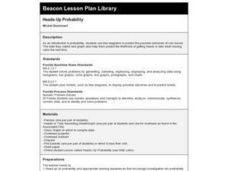Curated OER
Who's Who In My Family (Book Share)
Students read Who's Who In My Family, relate the story to their own family relatives, traditions and heritage and compare with classmates. They make their own family trees and form a live action family tree.
Curated OER
Vector Practice Problems
For this vectors worksheet, students draw scale diagrams and solve the problems using trigonometric methods. Students determine angles, speed, and components of force. This worksheet has 7 problems to solve.
Curated OER
Tennis Triangle
Learners calculate the height of a tree or flagpole. They measure the shadow of the tree or flagpole and the length of a shadow of a meterstick. Using similar triangles, calculate the heigh. Devise two additional ways in which to measure...
Curated OER
Business 90 Midterm 2: Probability
In this probability worksheet, students examine given business situations and determine the probability of an event. They create tree diagrams and contingency tables. This nine-page worksheet contains 7 multi-step problems.
Curated OER
Animals, Soil, Trees
Fourth graders describe the various kinds of soils and how plants and animals are affected by them. They describe the baic needs of plants, scoring at least a 3 or 4 on a 4-point rubic. Students are able to predict and/or infer what...
Curated OER
Probability - Worksheet
Middle schoolers solve and complete four various types of problems. First, they list all the possible orders completed. Then, pupilscomplete the table and show all the outcomes of throwing a coin and spinning a spinner. They also use a...
Curated OER
Flowering Plants
In this flowering plants worksheet, students compare the structure and function of a tree trunk and a leaf. This worksheet has 1 true or false and 5 fill in the blank questions.
CK-12 Foundation
Add and Subtract Decimal Numbers: Losing Little Bits
An interactive offers five questions that challenge scholars to subtract decimals. A diagram featuring a tree and birdhouse with moveable parts is designed to assist mathematicians in finding solutions. Types of questions include...
Curated OER
Raven Chapter 35 Guided Notes: Plant Form
The ups and downs of plant vascular tissue are described by your beginning botanists as they complete this worksheet. Xylem and phloem are defined and identified on actual color photographs. Functions of the different types of meristem...
Curated OER
Forestry and Forestry Products
High school and college learners identify forestry career opportunities. They identify the parts of a tree cross-section and trees based on their leaves and characteristics. Pupils calculate board feet and explain safe methods of...
Curated OER
Megabeasts
Create larger-than-life insects for the classroom. Bugs are usually pretty small, but during the Jurassic period they were huge. Kids use diagramming and scale conversion to enlarge a modern day insect so that it is as big as its ancient...
Curated OER
The Biogeochemical Cycles
The majority of this presentation is a collection of diagrams and graphs that back your lecture on biogeochemical cycles. The last few slides define ecosystems and the Gaia hypothesis. You may find these slides valuable, but will...
Curated OER
Poetry Writing Practice
In this poetry writing worksheet, students identify the topic, similes, metaphors, onomatopoeia, rhyme scheme, and alliteration in a poem. Students fill out this information in a given diagram.
Curated OER
Singing for the Animals
Learners examine the correct attitudes and poster for a concert. In this "Singing for Animals" lesson, students created charts to diagram information about the homeless animals they were singing for. Learners used correct diction and...
Curated OER
Functions of Leaves
The title is a little deceiving since only one of 17 slides is dedicated to the function of leaves, while the rest is dedicated to the structure. Both internal and external structure is taught with accompanying diagrams. If you are going...
Balanced Assessment
Initials
Learners explore the meaning of groups formed through permutations and combinations with an activity that asks individuals to determine the total number of pupils needed to guarantee that at least one pair has the same initials....
Curated OER
Heads-Up Probability
Second graders use tree diagrams to predict the possible outcomes of coin tosses. The data they collect and graph also help them predict the likelihood of getting heads or tails when tossing coins the next time.
Curated OER
Structure and Function of the Federal Government
Students identify the structures of the federal government. They complete a diagram of the structures to show their relationships. They research the names of the major players on the structure, in particular, students own representatives.
Curated OER
Brian's Pegboard II
Young scholars are able to assess a problem and use systematic methods to solve the problem. They also find out all the possible outcomes for a sequence of events using tree diagrams.
College Board
Power in Tests of Significance
Test your knowledge of tests of significance. A curriculum model for AP® Statistics describes and defines power in terms of tests of significance. It also provides two classroom activities designed to investigate power and how it relates...
Virginia Department of Education
A Crystal Lab
Young chemists grow ionic crystals, metallic crystals, and supersaturated crystals in three different lab experiments. Observing these under a microscope allows pupils to compare the various structures.
Curated OER
Rainforests
Students research and identify locations of the rainforest. In this rainforest lesson, students view a world map and identify the locations of the rainforest. Students use a Venn diagram to compare and contrast the similarities between...
Curated OER
Abiotic and Biotic Factors
Students examine abiotic and biotic factors. They define biotic and abiotic, categorize a list of items onto a Venn diagram, label various items from areas on the school grounds as biotic or abiotic, and diagram a magazine picture.
Curated OER
How Ecosystems Change
In this ecosystems worksheet, students will look at 4 diagrams and determine if either primary or secondary succession would occur after that particular event happened. Then students will determine the limiting factor for 4 different...
Other popular searches
- Tree Diagrams Probability
- Math Tree Diagrams
- Tree Diagrams for Math
- Branching Tree Diagrams
- Tree Diagrams Dice Game
- Grammar Tree Diagrams
- Tree Diagrams Hurricanes
- Tree Diagrams and Probability
- Probability With Tree Diagrams
- Branching Out Tree Diagrams
- Outcomes and Tree Diagrams
- Tree Diagrams for Probability























